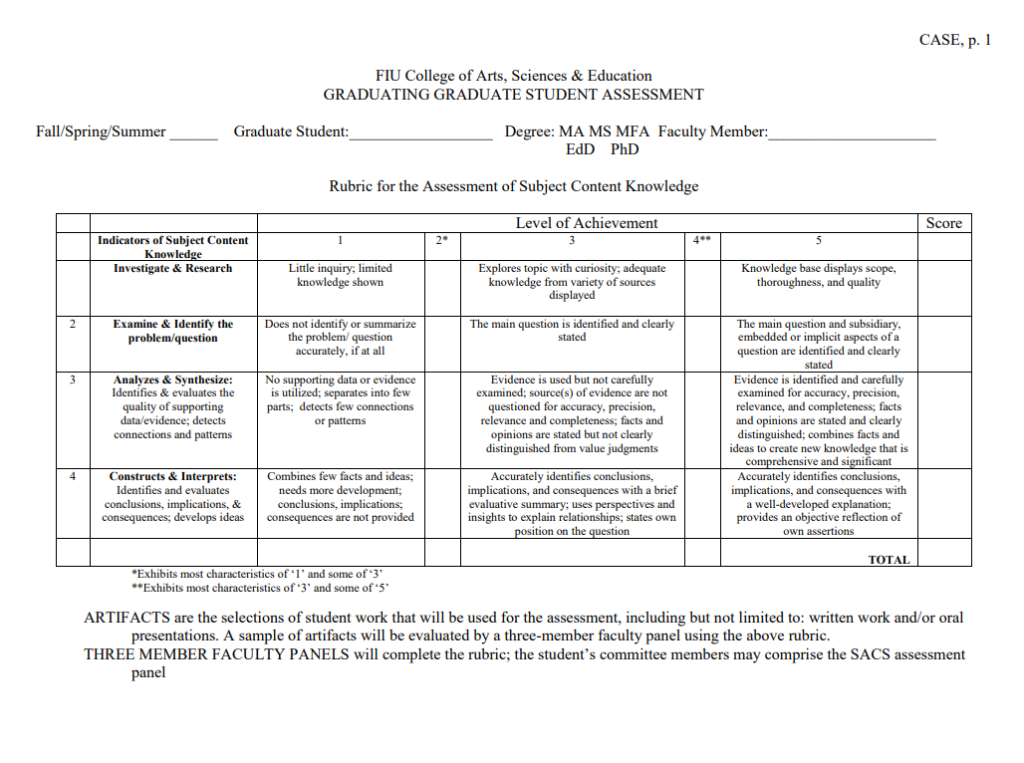Building and Using Rubrics in Assessment
No matter your chosen assessment method, the question we aim to answer at the end of the assessment process is; “What are graduate students learning and where is there room for improvement?”
One way to do this is by having a rubric that aligns with your program learning outcomes, so that you can identify levels of learning and achievement. For more information on how to build and use rubrics in your program, please see our workshop videos Using Rubrics to Improve Learning and Using Rubrics in Graduate Assessment.
Below are several examples of rubrics from other universities, with brief critiques provided by OIRA regarding strengths and weaknesses/ways to improve on the example rubrics. The examples we provide can hopefully guide you in your rubric-building process, though they are not meant to be copied as-is.
Florida International University; Oral, Written and Subject Content Knowledge
Positive Notes: Having open columns for ‘2’ and ‘4’ leave room for an in-between score for when you aren’t sure that a student met all requirements. Overall, this rubric gave very specific details on the scoring requisites and is a strong example.
Possible changes: Adding a comment section where scoring judges could discuss their answers and elaborate if a student receives a ‘2’ or ‘4’. More calibration may be needed among faculty if descriptions are absent for any achievement levels on a rubric.
In the oral presentation rubric, we see a potential inclusivity problem with the delivery scoring. Eye contact varies among different cultures; so do many aspects of our body language. Reorganizing this section to be inclusive to differences among cultures is recommended.

University of Northern Iowa; Oral Presentation Rubric
Positive Notes: This rubric utilizes descriptive scoring categories and the layout is easy to follow and understand. The descriptions in each scoring category may be useful for departments creating their own rubric.
Possible Changes: The rubric should be edited so the alignment to the learning outcomes being assessed is clear, possibly by including the outcomes above or below the rubric. This will make it transparent what the rubric is meant to do. This rubric uses a 1-4 achievement scale, using a more descriptive achievement scale (something like, Emerging, Approaching, Achieving, Exceeding) is helpful for quickly interpreting rubric scores.
As in the last example, consider re-wording the presentation portion to be more inclusive.
James Madison University; Graduate Thesis Rubric
Positive Notes: The brevity and flow of this rubric is concise and this layout may be easier to follow than others.
Possible Changes: Adding descriptions to the scoring numbers would make this rubric less subjective. Also, the “overall rating” on the last page should be more concise and relate better to the outcomes being assessed, for example; “to be at this level, students should…”

Cal State Fullerton; English MA Exam Rubric
Positive Notes: The descriptions in this rubric are thorough and easy to follow, it would be a good fit for English programs and potentially others, with a few adjustments.
Possible Changes: Breaking up the descriptions in each box and adding content criteria would help make alignment to outcomes more clear.

Cal State San Marcos; Multi-Rubric Thesis
Positive Notes: This rubric builds a progression from novice to proficient to advanced levels for each criteria, potentially making it easy for users to efficiently score elements of a written thesis. It also provides some useful ideas for the kinds of criteria that can be assessed through a written thesis.
Possible Changes: This rubric focuses on what students did without addressing the quality of work. Since part of the purpose of a rubric is to make learning expectations explicit, it would be helpful to add description regarding the quality of what is expected for each level.



